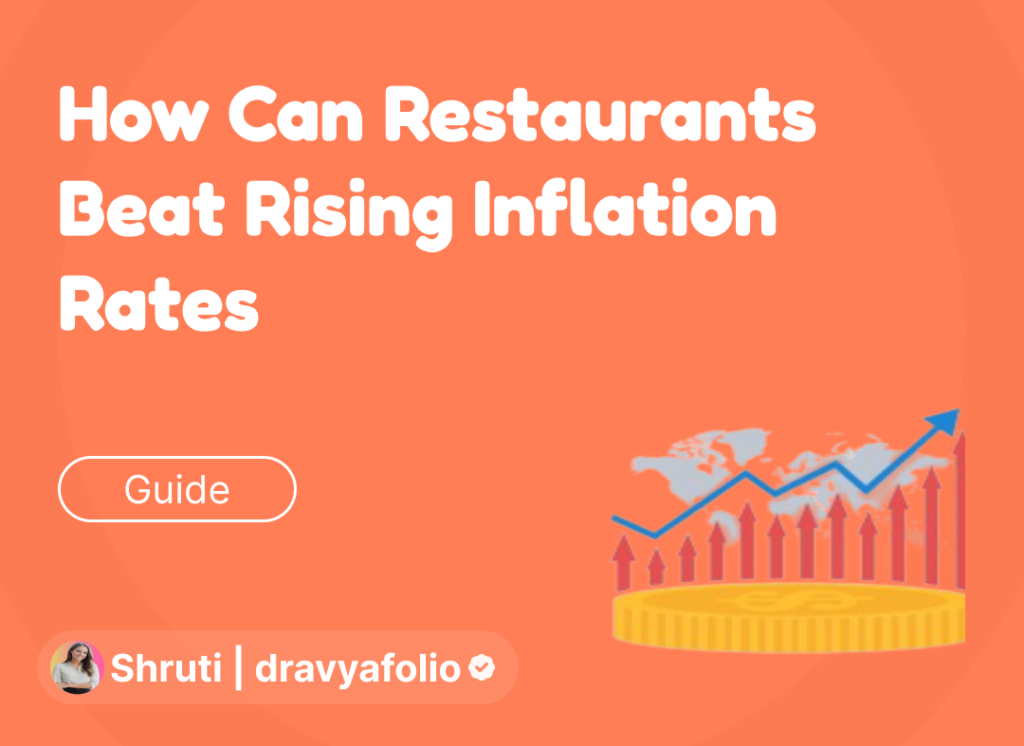Inflation is soaring and disrupting many businesses, including the food industry. Restaurant owners are confronted with higher costs, decreasing numbers of customers, and their inability to build a strong team.
As inflation in restaurants restricts business growth and customer footfall, it becomes challenging to operate a business seamlessly. Because restaurant owners may not be able to provide the same quality or quantity of ingredients at lower prices. So, striking a balance between maintaining profitability and delivering value to customers becomes paramount.
Understanding Food Inflation
Definition:
Food inflation refers to the increase in the prices of food items over time, leading to higher overall food costs for consumers and businesses alike.
Factors Contributing to Food Inflation:
- Supply Chain Disruptions: Issues such as transportation challenges and supply chain disruptions can lead to increased costs.
- Rising Input Costs: Higher costs of ingredients, labor, and utilities contribute to overall inflationary pressures.
- Increased Demand: Surges in consumer demand can strain the supply chain and result in higher prices.
Strategies to Navigate Food Inflation:
1. Menu Optimization and Diversification:
- Approach: Regularly review and optimize the menu by identifying high-margin items. Introduce new dishes that utilize cost-effective ingredients without compromising quality.
- Benefits:
- Cost Efficiency: Focus on items with favorable ingredient costs.
- Customer Engagement: Keep the menu fresh to entice repeat visits.
2. Dynamic Pricing Models:
- Approach: Implement dynamic pricing strategies that adjust menu prices based on factors like ingredient costs, demand, and seasonality.
- Benefits:
- Flexibility: Adapt pricing in response to changing cost structures.
- Profitability: Ensure prices align with current market conditions.
3. Supplier Negotiations and Partnerships:
- Approach: Establish strong relationships with suppliers. Negotiate bulk discounts, explore local sourcing options, and consider long-term partnerships for stability.
- Benefits:
- Cost Savings: Negotiate favorable terms to mitigate cost increases.
- Reliability: Build partnerships for consistent and reliable supply.
4. Technology Adoption for Efficiency:
- Approach: Leverage technology for inventory management, automated ordering, and kitchen efficiency. Implementing restaurant management systems can streamline operations.
- Benefits:
- Operational Efficiency: Reduce waste and optimize resource utilization.
- Cost Control: Utilize data-driven insights for better financial management.
5. Strategic Marketing and Promotion:
- Approach: Implement targeted marketing campaigns and promotions to drive customer traffic. Highlight value offers, loyalty programs, and special promotions.
- Benefits:
- Customer Retention: Incentivize repeat business through promotions.
- Brand Visibility: Enhance visibility through strategic marketing.
6. Portion Control and Meal Customization:
- Approach: Implement portion control measures without compromising quality. Offer meal customization options to cater to varying customer preferences.
- Benefits:
- Cost Management: Control ingredient usage while maintaining customer satisfaction.
- Customer Satisfaction: Allow customization for a personalized dining experience.
7. Staff Training and Retention:
- Approach: Prioritize staff training to enhance efficiency. Implement retention strategies, such as competitive wages and employee benefits.
- Benefits:
- Productivity: Well-trained staff contribute to operational efficiency.
- Consistency: Retain experienced staff for consistent service.
8. Sustainable Practices:
- Approach: Embrace sustainable practices, such as reducing food waste, recycling, and energy efficiency. Communicate these efforts to environmentally conscious customers.
- Benefits:
- Cost Reduction: Reduce waste-related costs and energy expenses.
- Brand Image: Appeal to eco-conscious customers.
9. Collaborative Initiatives:
- Approach: Collaborate with industry peers for joint purchasing, sharing resources, and collective initiatives to address common challenges.
- Benefits:
- Collective Bargaining: Pool resources for joint procurement.
- Industry Influence: Collaborate on industry-level initiatives for positive change.
10. Continuous Monitoring and Adaptation:
- Approach: Regularly monitor market trends, consumer preferences, and economic conditions. Stay agile and be prepared to adapt strategies as the situation evolves.
- Benefits:
- Proactive Decision-Making: Anticipate changes and adjust strategies accordingly.
- Resilience: Navigate challenges with a proactive and adaptive approach.
What is Food Inflation?
Food inflation is the rise in prices of food commodities. It focuses solely on the rising cost of food products.
It is measured using an index that tracks the prices of a basket of food items commonly consumed by households. This index helps monitor how the cost of food is changing and provides insights into trends and patterns related to food prices.
What are the Causes for Inflation in your Country?
Inflation has always remained a major challenge. And tackling it has always been tricky. It can be caused by several factors like changes in production costs, money supply, consumer demand, and global factors.
While these may be common factors worldwide, it is important to understand the root causes in the specific country. The following are some causes of inflation in India:
- Monetary Factor: The actions of the central bank and changes in the money supply can highly impact inflation. For instance:
- Excessive money supply growth can lead to higher demand and potential inflation.
- Changes in interest rates can affect borrowing and spending behaviour.
- Demand-Pull Inflation: This type of inflation occurs when demand exceeds the supply of goods and services. Demand-pull inflation occurs because of increasing consumer spending, high levels of government expenditure, and easy availability of loans.
- Cost-Push Inflation: It occurs due to the rise in production costs. This rise happens due to factors like rising wages, taxes, and the cost of raw materials. As the production cost increases, so does the price of goods and services.
- Global Factors: We must not forget that India is an important part of the global economy. So international factors can have a huge impact on inflation in India. This may happen due to:
- Fluctuations in global commodity prices, such as oil and food, can affect domestic prices.
- Exchange rate movements can impact the cost of imported goods and services.
- Government Policies: Certain policies and regulations can impact inflation:
- Subsidies on essential goods can lead to excess demand and higher prices.
- Trade policies and import restrictions can affect supply and prices.
Food inflation in restaurants can be caused by a combination of these factors. When you closely monitor these factors, you can take appropriate measures to combat the negative inflation impact.
Start by these 8 Strategies to Deal With Inflation for Restaurants
1. Analyse your menu items
Your restaurant might be doing well. But despite this, there might be a few items on your menu that aren’t selling well. So, you should immediately remove these items. It will eliminate food and labour costs, and reduce the inflation impact.
2. Reconsider your menu pricing
One of the ways to control the rising food inflation in restaurants is to reconsider the menu pricing. And before you do it, you should analyse a few things: Is your customer footfall decreasing? Are customers opting for less expensive food items?
Answer these questions and set the price of food items accordingly. Integrating a good POS system can help you continually monitor these questions, making it easy for you to make wise decisions. In addition to this, switch to less expensive ingredients to offer more affordable options to the consumers.
3. Reduce food wastage
You can optimise your menu and focus on dishes that require common ingredients. This can reduce the risk of ingredients becoming obsolete due to changing customer preferences or spoilage. Additionally, do creative use of food scraps. For example, vegetable peels can be used to make broth and bread ends can be turned into breadcrumbs.
Make sure you properly train your staff to do more mindful practices in the kitchen and during service to avoid food wastage.
Minimising food waste can control costs and maintain your profit margins. It can reduce the impact of inflation and also contribute to a more efficient food industry.
4. Focus on food portion
Portion control is an important strategy for restaurants to manage expenses and maintain profitability during inflation. It happens due to the rising cost of ingredients and operational expenses.
It allows you to maintain profit margins by ensuring that the cost of ingredients in each dish is aligned with its selling price. Moreover, implementing portion control can also help in minimising food wastage.
Even though you may not cut down the price to an extent, portion control ensures that each dish is consistent in terms of taste and presentation.
5. Understand consumer behaviour and communicate with them
Understanding consumer behaviour during inflation is crucial for restaurants because it directly impacts how they can adapt their strategies to maintain customer satisfaction, manage costs, and remain competitive.
Maintain honest and transparent communication with them. Communicate the reasons behind the price adjustment, such as inflation and the rising cost of ingredients. Emphasise the restaurant’s commitment to quality and customer satisfaction despite the changes.
Frequently communicating with them can help you understand their perspective and overall mindset regarding price adjustments. This helps in decision-making without compromising customer satisfaction.
Remember, restaurants that understand and respond to consumer behaviour during inflation are better equipped to adapt their offerings, pricing, and strategies in ways that maintain customer satisfaction and business viability.
6. Streamline your supply chain
Making efficient supply chain management is critical for ensuring the availability of the right ingredients. Additionally, you can make a list of vendors near you and see if any of them take bulk orders at a discounted price. Maintain a strong relationship with them, so they offer timely discounts and deliveries.
A well-managed supply chain reduces the impact of price fluctuations on your restaurant operations. By establishing stable supplier relationships and negotiating contracts, your restaurant can mitigate sudden price hikes that can occur during inflation.
7. Consider adjusting labour and operating hours
Labour costs are a significant component of any restaurant’s expenses. During inflation, wages and other labour-related costs may increase. Adjusting labour hours, such as reducing overtime or optimising shifts, can help control labour expenses without compromising service quality.
Restaurants can adopt more flexible staffing models, such as part-time or seasonal workers, to match fluctuating demand. This allows you to scale up or down based on customer traffic, avoiding overstaffing during quieter periods.
Plus, inflation can influence the availability of labour. In a tight labour market, it might be more challenging to find and retain staff. So, adjusting operating hours to accommodate labour availability can help maintain service quality.
8. Offer limited rewards to customers
Inflation isn’t the best time to offer discounts, gift vouchers, or other rewards to customers. But some offers and deals can encourage customers to continue dining at your restaurant and save your costs simultaneously.
For instance, you can design a loyalty program and introduce special rewards to your loyal customers. This will improve your retention rate and ensure consistent business even during periods of lower demand.
Moreover, if you have excess inventory of certain ingredients, you can create limited-time offers that feature these ingredients, reducing waste and managing costs.
Wrapping Up
Inflation, rising prices, and increasing labour costs in the restaurant industry are inevitable. It can affect your revenue and profit margins. However, leveraging solid processes, smart systems, and powerful strategies can help reduce the impact of inflation in restaurants.
These factors drive business growth, profits, and customer satisfaction. The trick is to do it the right way and see your profits improve. Inflation has slowly started hitting a lot of businesses, including the restaurant industry. Enabling a strategic approach will keep your guests happy and elevate your business.








